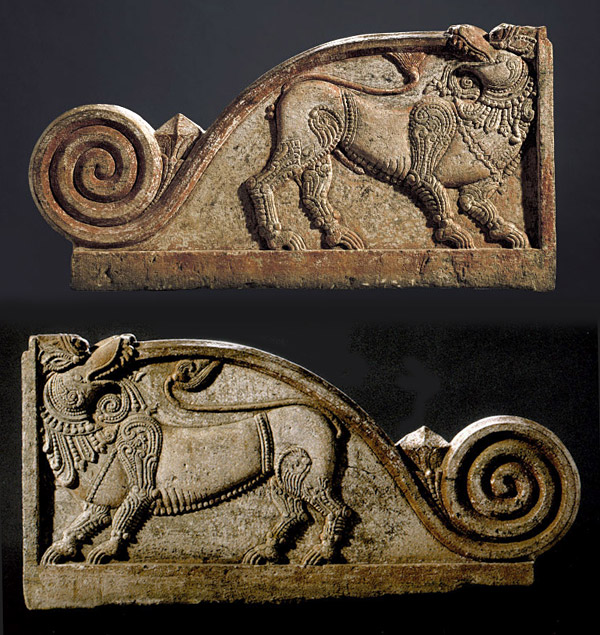|

A Yali is an imaginary mythical composite beast. It has the body and head (with its raffle like mane) of a lion and in addition it is depicted with horns. The Yali (also termed �Vyala� in the north of India) is the personification of rampant natural forces. The function of these mythical lions is to define open spaces. The balustrades were originally positioned at the main entrance of a temple or palace, flanking the central aisle. The Yalis are depicted with their claws planted firmly on earth, with bulging eyes and open mouth, and looking back over their shoulders, pacing towards the building they are protecting.
Both Yalis, one male and one female, are standing with their four paws on the earth, their heads are turned backwards over their shoulders, and they are portrayed with an open mouth, protruding teeth, and tongues sticking out, round bulging eyes and horns and are decorated with a necklace with bells, strings of pearls and ornaments. From their open mouths with redoutable fangs, they spit out the scalloped edge of the balustrade (the banister) to end in a circular spiral form. Both tails are bent in the direction of their heads, just above their bodies. A lotus is depicted between the banister and the spiral, symbolising spiritual elevation. The shape of the staircase is divided into four levels and is still visible at the reverse of the stones.
Yalis are the most conspicuous composite animals on the piers of temples in Sri Lanka and South India, dating to the fifteenth and sixteenth century. The present stones show stylistic influence from the vijayanagar kingdoms in Tamil Nadu. In the wake of the long lasting Chola occupation and presence of numerous South Indian residents, it is natural that stone sculptures of the Divided Kingdom period reflect a prominent South Indian influence. During this period of political instability (circa 1232 - 1597 A.D.) the island was divided among different rulers and chieftaincies.
Tamil yalis are less abstract in form, are more dimensional, decorative and robust in comparising to the Sri-Lankan balustrades which are carved in a typical low relief and are of a more archaic expression than their neighbouring examples. Similar stylistic characteristics can be found on ivory boxes dated to the divided kingdoms period and on weaponry, both of the 16th century. The stones show stylistic similarities with a gaja-simhanada balustrade, in the National Museum of Kandy which is dated to the 14th century.
The well balanced variety of shapes, volumes, ornaments, muscles and surfaces enhance the powerful dimensions of these superb carvings in hard stone low-relief. The consistent quality of the stones comprise strings of pearls and ornaments which are suggestive of the tension in the muscles of the animals. The lively aspect of these mythical lions is enhanced by the bulging eyes, open mouth with protruding teeth, and the turning of their heads. In addition they are strengthened by the striking curve of the upper banister ending in a spiral, and by the movement of the tails. These wonderful mythical lions express a sense of ancient magical tales and mysterious fairy lands. The stones are among the rare monumental sculptures from Sri-Lanka and are unique in western collections.
Provenance: Formerly in the collection of Sir Christopher Chancellor, England.
|

